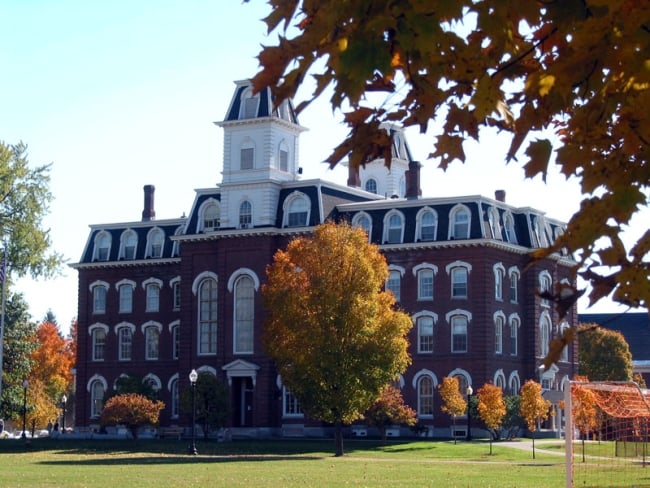You have /5 articles left.
Sign up for a free account or log in.

The Vermont College of Fine Arts has struggled with declining enrollment over the past two years.
Hannahmorris/Creative Commons
When the Vermont College of Fine Arts announced its plan to enter into an affiliation agreement with the California Institute of the Arts last week, the New England institution averted joining the growing list of independent art colleges that have closed in recent years.
The deal offers a glimmer of hope in an uncertain era for art colleges, which some advocates say are critical to upholding freedom of expression.
“It is in the core of their DNA as institutions,” said Deborah Obalil, president and executive director of the Association of Independent Colleges of Art and Design (AICAD). “In some ways the closure of art schools, particularly those focused on fine arts, is the canary in the coal mine of concern around freedom of expression in our society as a whole.”
Over the past decade, budget cuts, enrollment declines and a growing public skepticism about the value of arts and humanities degrees have diminished arts departments at colleges and universities throughout the country. For small independent art colleges—which typically have small endowments and are highly dependent on tuition revenue—navigating the enrollment declines affecting the entire higher education sector has been exceptionally difficult.
“A lot of challenges facing the art and design colleges that have closed over the past decade mirror those that have faced very small higher education institutions in general,” Obalil said. “They don’t have the benefit of the savings that come from having a certain scale of students.”
The expense of delivering art education, which often requires specialized equipment and space, only compounds those struggles.
“When you’re solely focused on that as an institution, you don’t have the ability to amortize that against other disciplines that require solely faculty and a classroom,” Obalil said. “There are costs to delivering that type of education that other institutions either don’t have or [not] at the same percentage.”
In addition to the total shutdown of the Art Institutes, a troubled system of for-profit colleges, last year, numerous other art colleges have recently closed, including the Memphis College of Art and the San Francisco Art Institute. In January, the Pennsylvania Academy of the Fine Arts announced that it would stop offering degree programs after the 2024–25 academic year. (Note: This paragraph was revised to remove Lyme Academy of Fine Arts from the list of recently closed art colleges.)
Other cash-strapped art colleges have merged with larger institutions to stay afloat. The Corcoran College of Art + Design became part of George Washington University in 2014; In 2016, the School of the Museum of Fine Arts in Boston became part of Tufts University. And as of 2020, Belmont University in Nashville has absorbed both the O’More College of Design and the Watkins College of Art.
A Challenging Environment
Vermont College of Fine Arts (VCFA) administrators have worried for the past couple of years that the institution’s enrollment struggles could result in closure, which would have ended the innovative art education model it launched more than 15 years ago.
The college opened in Montpelier in 2008 on the former campus of Vermont College, and exclusively offers graduate degrees. Students take classes remotely, but come to campus twice a year for a nine-day residency. (The residencies have been hosted at Colorado College and Susquehanna University in Pennsylvania for the past two years.)
“We believe students do their best when they’re in their own communities, residing in the places where they actually do their art and their work,” Andrew Ramsammy, interim president of VCFA, said. “When artists are looking for a respite to think about what’s next, these residencies offer an opportunity to bring our community together.”
That model made for a relatively smooth transition to entirely remote learning during the pandemic, and the college experienced enrollment growth, according to Ramsammy. But that growth didn’t last. Between 2022 and 2024, VCFA’s enrollment dropped from about 340 to 215 students.
“This space is challenging,” Ramsammy said. “We are a very niche institution. We’re not large and we don’t necessarily have the brand name recognition other institutions have. It made it increasingly challenging to be a standalone institution and be able to deliver student-centric education.”
In an effort to avoid closure, VCFA started selling off buildings and looking for an affiliate institution, which it found in the California Institute of the Arts, known as CalArts.
CalArts, which has a strong focus on incorporating technology into art making, is a much larger institution than VCFA. Though it’s enrollment has also declined since the pandemic—from 1532 students in fall 2019 to 1353 in fall 2023—CalArts is “fiscally sound,” said Ravi Rajan, president of CalArts.
“We have a niche. We’re in Los Angeles and the economy is significantly driven by creative industries,” Rajan said. “All of those things work in our favor.”
CalArts also didn’t have any low-residency graduate programs, like those offered at VCFA.
“In some ways our missions were complementary in terms of the disciplinary focus, but we’re very different in the format of degree programs and how a student would carry out the curriculum.” Rajan said, noting that some faculty and alumni at CalArts already had relationships with VCFA. “The people who are gainfully employed and have family responsibilities can’t move for two or three years and sequester themselves to do a graduate program. They’re able to do both of those things simultaneously in a low-residency program.”
Under its affiliation agreement with CalArts, which is expected to be formalized by July pending approval from the institutions’ governing boards and accreditors, VCFA will come under the umbrella of the CalArts.
The VCFA, which will cease the majority of its operation in Montpelier and will retain all of its faculty but eliminate 11 current staff positions. The college will be able to access shared administrative and student services as well as other institutional support and guidance. Beginning in 2025, VCFA students will come to CalArts’ campus in Santa Clarita to participate in the college’s signature biannual residency program.
Space for Civic Discourse
Finding a path forward for VCFA also means maintaining a learning model that prioritizes freedom of expression and flexibility over the often formal, linear approach of traditional higher education.
“Formal schools create inflexible students. We need to create more flexibility in how we approach challenges and issues,” Ramsammy, VCFA’s interim president, said. “The goal of all of this is to create civic discourse. We have to be able to create artists that are willing to stand up and push back against some of the oppressive things happening in our country.”
Jennifer Rissler, president of the College Art Association, said she’s optimistic that VCFA’s move will inspire more struggling art colleges to find affiliations and partnerships instead of closing altogether. That is what she tried to do as chief academic officer of the San Francisco Art Institute (SFAI) when enrollment fell from a high of some 1,000 students to around 300 right before the pandemic.
“We had a singular focus on the fine arts, meaning we didn’t have applied arts, so we had a shrinking pool of students based on that,” Rissler said, noting that other art colleges, such as the California College of the Arts, have put more emphasis on architecture, design and other modalities with clearer career applications.
“There are many reasons for that: shifting demographics, shifting comfort levels of parents in terms of careers, the focus universities are placing on job placement,” she said. “Once that started happening it was more difficult for institutions to show that being a practicing artist is a viable career, which I believe it is."
While SFAI had discussed the possibility of the University of San Francisco absorbing them, the deal never materialized “for many reasons,” Rissler said. While she’s not sure of the exact number of art colleges operating in North America, she estimates that in the late 1990s there were about 42 compared to around 36 now.
SFAI graduated its last class (of around 50 students) in 2022 and filed for bankruptcy last year. But last month, a nonprofit backed by wealthy donors including Laurene Powell Jobs (widow of Apple co-founder Steve Jobs) purchased the campus for $30 million, according to The San Francisco Chronicle. The plan is to use it as an arts space, though the exact details are still unclear.
In the meantime, Rissler said finding a way to keep art colleges and departments—which typically have community exhibition spaces—alive is especially important during a time when some politicians and university administrators want to limit which topics and viewpoints can be expressed on campus.
“There’s a relation between exhibition practice and content that’s not going to be seen or put out to the public because you lose the site for that,” she said. “Art colleges play an important role in the dialogue and discourse around issues facing our society and culture. A lot of times those are issues that are very difficult to unpack and artists do it better than most.”




